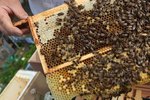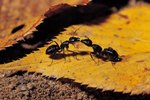
Burrowing into the hard crust of the earth with surprisingly powerful mandibles, hundreds of species of flying insects make their homes underground, From the curious cicada and parasitic predators like digger wasps to innocuous solitary bees, chubby bumblebees and fiery-tempered yellow jackets, an integral part of all these insects' lives is spent in cold, dark subterranean nests.
Swarmageddon
Considered symbols of rebirth by the ancient Chinese culture, cicadas have fascinated people for thousands of years. 3,000 known species of cicadas occur worldwide. Periodical cicadas include the large sub-species Magicicada septendecim, who live underground for 13 to 17 years, slowly growing from larvae to adults, then emerge to engage in an ear-splitting, musical mating ritual for four weeks, lay their eggs and die. People who live in the eastern half of the United States gear up for the invasion they call "Swarmageddon," a once-in-a-generation event when up to 30 billion of the the giant flies blanket trees, shrubs, houses and cars. Annual cicadas, such as dog day cicadas, have multi-stage life cycles but emerge every summer.
Don't Sweat the Solitary Bees
Little insects of infinite complexity, the Andrenidae family of solitary bees include more than 500 species in North America, such as mining bees. They are expert buzz-pollinators whose females burrow into the ground creating tunnel-like nests with smaller side tunnels ending in a single cell, which she stocks with pollen and nectar collected from flowers, then deposits an egg on top. When the larvae hatch, they consume the stored food, pupate, then become adult bees who overwinter in the burrow site. Among the members of the family Halictidae are metallic green bees (Agapostemon), orchid bees (Lasioglosum) and sweat bees (Halactus), who land on people on hot summer days to drink their sweat for the salt content. Small, shiny and mostly metallic green or blue, they are beneficial in the garden, and there's no need to worry about these expert little pollinators -- they're not aggressive..
Fat and Fuzzy Buzz-Pollinators
You can easily spot bumblebees; their large, round, furry black-and-yellow-striped bodies are twice the size of honey bees'. They have little pollen baskets, called anthers, affixed to their back feet. Energetic and proficient pollinators, these rotund giants often nest underground in old rodent burrows, in the soil under sheds or in compost piles in colonies of about 100 individuals. Queen bumblebees spend the entire winter hibernating in the soil, then emerge in spring to nest in the ground and lay eggs. The larvae spin cocoons, where they morphinto adult bumblebees. Proficient buzz-pollinators, bumblebees and many solitary bees release or dislodge pollen held by their anthers to increase the efficiency of pollination.
The Dirt on Digger Wasps
Digger wasps burrow into the ground to make nests composed of cells to hold captive insects, upon which they lay their eggs. Then they fly away, not returning to their nests again until winter. Cicada wasps paralyze their prey with toxins and drag the cicadas into their prison cells, where the hapless cicadas are eaten alive by the larvae. Sharing the same unfortunate fate, a variety of spider species are spider wasp prey. Great golden digger wasp offspring dine on grasshoppers, crickets and katydids. But these parasitic predators do have some redeeming qualities. They are beneficial in the garden as prolific pollinators, they don’t defend their nests, and they are not aggressive to humans.
Watch Your Step
With the ability to sting multiple times, ground-nesting yellow jackets are an aggressive species who pose a real threat when they're nesting in your yard. Sometimes occupying old rodent holes or digging holes from scratch, colonies may grow to thousands of individuals. Beneficial insofar as they prey on insects and garden pests such as caterpillars that consume plants, later in the summer they require more sugar in their diet and begin to hang around garbage and picnics, becoming more of a hazard for people. Bright yellow with black stripes around the circumference of their slender bodies, yellow jackets look almost like honey bees, and like honey bees they will fiercely defend their nests.
Six-Legged Home-Wreckers
Termites are lower in the evolutionary scale than ants and bees, but their social structure is very similar. A queen lays eggs, workers attend the eggs and collect food, and soldiers defend the nest. Subterranean termites are the only termites who live underground, requiring contact with the moisture in soil to survive. Although most members of the colony are wingless, the primary female and the male reproductives, called "swarmers," have four wings that take them on brief flights in spring or fall, after which the wings are broken off and discarded; then they mate in an attempt to establish a new colony. Swarms of winged termites, darker than other termites, are usually the first visual indication that subterranean termites have moved in.
Flying Kings and Queens
Often mistaken for winged termites, flying or swarming ants are distinguished by thin waists, elbowed antennae and longer forewings than hind wings. Although the destructive, wood-boring carpenter ant has swarming members, most do not live underground but nest in wood. Among the most successful of insects, hundreds of species of ants establish colonies in almost any kind of soil throughout the world. Like termites, the kings and queens of the colonies have wings that they drop once they mate; queens who do not mate retain their wings. Among the myriad species of ground-nesting ants commonly found in North America are field ants, trap-jaw ants, harvester ants, fire ants, big-headed ants, little black ants, leaf-cutting ants, little fire ants, cornfield ants, Argentine ants and honey ants.
Handle With Care
About 30 percent to 40 percent of all insects are beetles. They're easily distinguished from other insects by their forewings, which are modified into horny sheaths, completely concealing the hind wings when the insects are at rest. Some species' wings are fused, but most adults fly. Several species are burrowers who live underground. A notable example is Derobrachus geminatus, the palo verde borer beetle, because the species' larvae develop underground and feed on the roots of palo verde trees and other plants. Dark brown, with spines on their thoraxes, long straight antennae and large mandibles, Derobrachus geminatus are active during the summer and swarm around outside lights at sunset. These large beetles squeak when picked up, and their powerful mandibles deliver painful bites.
References
- National Post: Swarming of Cicadas
- Bee Friendly: Miner Bees
- Bee Friendly: Sweat Bees
- National Geographic: Cicada
- Pennsylvania State University, Department of Entomology: Cicada
- University of Maryland Home and Garden: Mining Bees and Ground-Nesting Wasps
- Terminix Pest Blog: Solitary Ground-Nesting Bees and Wasps
- Bumblebee Conservation: Bumblebee Nests
- Bumblebee Conservation: Bumblebee Life Cycle
- Magicicada.org: Magicicada Septendecim
Resources
- All the Dirt on Gardening: Digger Wasps
- Insect Museum: Halictidae, Sweat Bees
- Gardeners Supply Company; All About Yellow Jackets, Bees and Their Kin; Susan DeJohn
- Scientific Guide to Pest Control Operations; Lee C. Truman, Ph.D. et al.
- Termites 101: Termite Basics
- The Living World of Animals; The Reader's Digest Association and World Wildlife Fund
- Desert Ecology of Tucson, Arizona, Pima Community College: Arthropods of Tucson, Arizona
Photo Credits
-
John Foxx/Stockbyte/Getty Images
Writer Bio
Based in Ontario, Susan Dorling has written professionally since 2000, with hundreds of articles published in a variety of popular online venues. Writing on a diverse range of topics, she reflects her passion for business, interior design, home decorating, style, fashion and pets.



